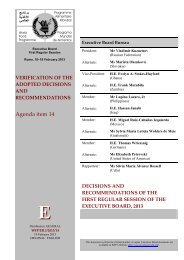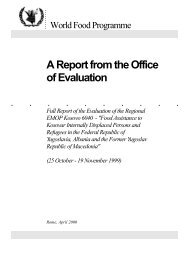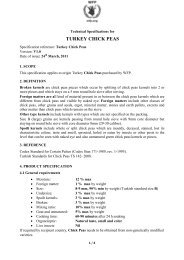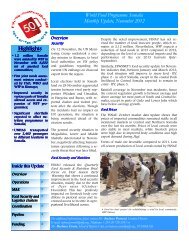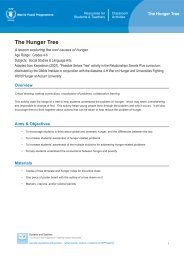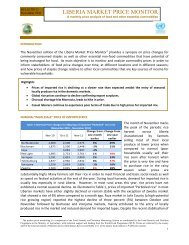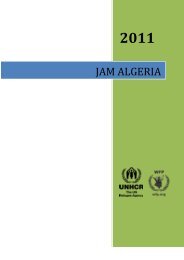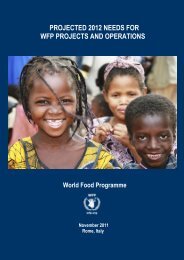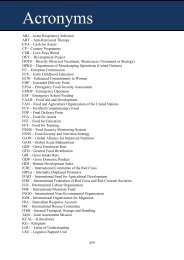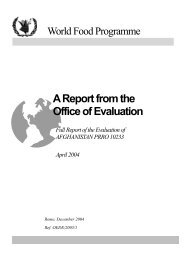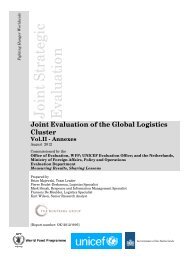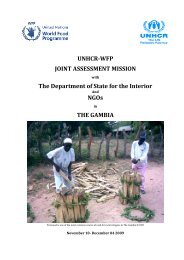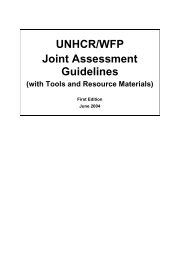The Potential for Scale and Sustainability in Weather Index Insurance
The Potential for Scale and Sustainability in Weather Index Insurance
The Potential for Scale and Sustainability in Weather Index Insurance
You also want an ePaper? Increase the reach of your titles
YUMPU automatically turns print PDFs into web optimized ePapers that Google loves.
18<br />
CHAPTER 1<br />
RISK IN AGRICULTURE<br />
Governments <strong>and</strong> relief agencies<br />
Governments <strong>and</strong> relief agencies frequently <strong>in</strong>tervene where losses have a catastrophic<br />
impact <strong>and</strong> the local cop<strong>in</strong>g capacity is weak or non-existent. Driven by humanitarian<br />
concerns, their primary objective is to save lives <strong>and</strong> rebuild assets. Although<br />
humanitarian <strong>in</strong>terventions have proven <strong>in</strong>dispensable <strong>in</strong> times of need, they have<br />
also been beset by a number of problems:<br />
• It is difficult to target relief aid to the truly needy; large leakages to others are common.<br />
• Emergency relief might arrive too late.<br />
• Food aid can distort <strong>in</strong>centives <strong>and</strong> depress local prices <strong>for</strong> farmers. Moreover, once<br />
disaster assistance has been <strong>in</strong>stitutionalized, <strong>and</strong> people know they can rely on it,<br />
people may <strong>in</strong>advertently be encouraged to <strong>in</strong>crease their future exposure to<br />
potential losses. Assured compensation <strong>for</strong> flood damage to homes, <strong>for</strong> example,<br />
can lead to the construction of more houses <strong>in</strong> flood-prone areas.<br />
• Fund<strong>in</strong>g <strong>for</strong> humanitarian relief <strong>in</strong> the face of catastrophes is not assured, <strong>and</strong> it often<br />
depends on appeals to <strong>in</strong>ternational donors after the crisis has already occurred.<br />
Many governments have attempted to help farmers manage more frequent <strong>and</strong> less<br />
covariate risks <strong>in</strong> order to protect assets <strong>and</strong> promote development (e.g. crop <strong>in</strong>surance<br />
<strong>and</strong> livestock feed programmes dur<strong>in</strong>g droughts). <strong>The</strong> experience has generally been<br />
unfavourable, at a high cost with low ga<strong>in</strong>. <strong>The</strong>se k<strong>in</strong>ds of risks are subject to moral<br />
hazard <strong>and</strong> asymmetric <strong>in</strong><strong>for</strong>mation problems, <strong>and</strong> their higher frequency makes the<br />
premiums too expensive <strong>for</strong> farmers, unless they are heavily subsidized. <strong>The</strong><br />
government itself may f<strong>in</strong>d this level of support unsusta<strong>in</strong>able over time; <strong>and</strong> the loss<br />
adjustment <strong>and</strong> payout process can be difficult to manage effectively.<br />
When assess<strong>in</strong>g vulnerable populations, governments have typically failed to<br />
adequately differentiate between those who can af<strong>for</strong>d <strong>in</strong>surance <strong>and</strong> those who<br />
cannot. If suitable commercial risk-management <strong>in</strong>struments are available, some<br />
households are quite capable of bear<strong>in</strong>g <strong>and</strong> manag<strong>in</strong>g most of the risks they face <strong>and</strong><br />
do not need access to subsidized government <strong>in</strong>terventions, except <strong>in</strong> the event of<br />
major disasters. But there are many vulnerable households that lack this capacity, <strong>and</strong><br />
<strong>for</strong> which all risk-management <strong>in</strong>terventions serve primarily as social safety nets.<br />
<strong>The</strong>se safety nets can only be provided on a heavily subsidized basis. Mix<strong>in</strong>g these two<br />
types of clients leads to the design of public <strong>in</strong>terventions that are heavily subsidized<br />
<strong>for</strong> all <strong>and</strong> that end up be<strong>in</strong>g very costly, both <strong>in</strong> terms of their direct government cost<br />
<strong>and</strong> the economic <strong>in</strong>efficiencies they create through distorted <strong>in</strong>centives. If a clear<br />
dist<strong>in</strong>ction between the needs of these two types of households could be precisely<br />
differentiated, then more-efficient, targeted <strong>in</strong>struments could be designed.



